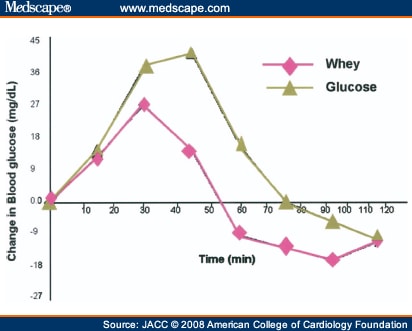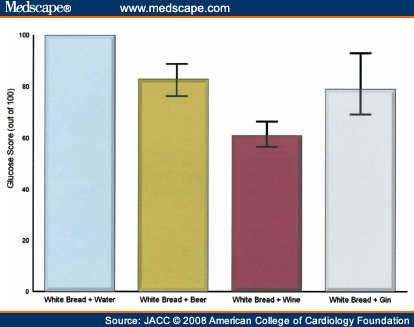Vinegar
A mixture of vinegar and olive oil is the traditional salad dressing used in the Mediterranean diet. The consumption of vinegar with meals was used as a home remedy for diabetes before the advent of pharmacologic glucose-lowering therapy. Indeed modern studies indicate that vinegar significantly reduces post-meal glycemia, probably because acetic acid slows gastric emptying and thus delays carbohydrate absorption and improves satiety. Recent studies show that 1 to 2 tablespoons of vinegar, when added to a meal containing high-glycemic-index foods such as white bread or white rice, will both: 1) lower post-prandial glucose by 25% to 35% (Fig. 5), and 2) increase post-meal satiety by more than 2-fold.[32] Thus the addition of vinegar to a standard meal can not only improve the meal-induced oxidant stress by blunting the post-prandial glucose excursion, but also can increase and prolong satiety, which should help to reduce food cravings and lower caloric intake over the subsequent 2 to 4 h. Finally, vinegar with olive oil is generally consumed with green leafy vegetables, which have superior nutrient-to-calorie ratios and very low glycemic indexes.
Figure 5.
 Vinegar Reduces Post-Prandial Glucose. The addition of 2 tablespoons of vinegar to 2 slices of white bread significantly reduced the post-prandial glucose increase. Data from Östman et al.[32] Vinegar Reduces Post-Prandial Glucose. The addition of 2 tablespoons of vinegar to 2 slices of white bread significantly reduced the post-prandial glucose increase. Data from Östman et al.[32]
High-Biological-Quality Protein
Protein is an important component of an anti-inflammatory, cardioprotective diet. Unfortunately, the favored protein sources in the modern diet, such as ground beef, sausage, bacon, and cheese, are high in both calories and saturated fats and tend to worsen post-prandial dysmetabolism.[3,11] In contrast, lean protein of high biological value will both reduce post-meal glucose excursion and improve satiety. In a study of healthy individuals, the addition of whey protein to a pure glucose drink lowered the post-prandial blood glucose area under the curve by 56%, and increased the insulin response by 60%[33] (Fig. 6). Additionally, dietary protein has a thermogenic effect whereby it increases the basal metabolic rate, which is not the case with ingested carbohydrates.[25] Thus, protein of high biological quality such as egg whites, fish, game meat (and other very lean red meats), skinless poultry breast meat, and whey protein (or other nonfat dairy protein) when eaten with meals will dampen down post-prandial inflammation and can help prevent obesity.[25]
Figure 6.
 Whey Protein Reduces Post-Prandial Glucose. Increases in blood glucose after either a glucose drink or the same glucose drink mixed with whey protein. Whey protein reduced the area under the curve for blood glucose by 56% (p < 0.05). Data from Nilsson et al.[33] Whey Protein Reduces Post-Prandial Glucose. Increases in blood glucose after either a glucose drink or the same glucose drink mixed with whey protein. Whey protein reduced the area under the curve for blood glucose by 56% (p < 0.05). Data from Nilsson et al.[33]
Calorie Restriction and Weight Loss
Weight loss of 5% to 10% or more, particularly when accompanied by decreased abdominal adiposity, lowers post-prandial glucose and reduces the risk of new diabetes.[25] Although weight loss can be achieved by any dietary modification that reduces calorie intake, strategies that restrict both processed carbohydrates and unhealthy fats (saturated and trans fats) improve post-prandial dysmetabolism, oxidative stress, and inflammation more effectively than other approaches.[1,2,25]
The degree of post-prandial dysmetabolism is closely related to calorie intake. On the extreme end of the spectrum, fasting completely eliminates post-prandial increases in glucose and triglycerides and the ensuing oxidant stress and inflammation. A reduction in calories by approximately 30% below the intake on an ad libitum diet has been shown to improve health and longevity in animal models.[34] A similar degree of calorie restriction in humans has been achieved by diets low in processed foods and high in vegetables, fruits, nuts, low-fat dairy, egg whites, soy protein, whole wheat, and lean meat that provides >100% of the daily value for all of the essential nutrients.[34,35] This diet was associated with improvements in oxidative stress, inflammation, glucose, insulin sensitivity, blood pressure, lipids, and cardiac function.[34,35] Although the ideal caloric intake for optimal health and longevity is yet to be determined in humans, the avoidance of energy-dense processed foods is a logical first step toward the reduction of excess calories.
Light to Moderate Alcohol Consumption
An extensive body of data shows concordant J-shaped associations between alcohol intake and a variety of adverse health outcomes including CAD, diabetes, stroke, dementia, and all-cause mortality.[36] Light to moderate alcohol consumption (0.5 to 1 drink daily for women, and 1 to 2 drinks daily for men) is associated with cardioprotective benefits, whereas increasingly excessive consumption results in proportional worsening of outcomes. Although alcohol increases high-density lipoprotein in a dose-dependent fashion, the effects on glucose homeostasis are nonlinear, conferring benefits at lower doses and harm at higher doses.[36] Randomized placebo-controlled trials in healthy nondiabetic individuals showed that 1 to 2 drinks immediately before a meal will significantly lower post-prandial glucose and insulin levels[37] (Fig. 7). Tellingly, the interaction between alcohol intake and post-prandial glucose follows the same J-shaped relationship that is seen between alcohol and systemic inflammation, as well as alcohol and adverse CV events.[36]
Figure 7.
 Alcohol Reduces Post-Prandial Glucose. In this group of healthy individuals, 20 g alcohol (approximately 1.5 drinks) in various beverages reduced postmeal glucose by up to 38%. Data from Brand-Miller et al.[37] Alcohol Reduces Post-Prandial Glucose. In this group of healthy individuals, 20 g alcohol (approximately 1.5 drinks) in various beverages reduced postmeal glucose by up to 38%. Data from Brand-Miller et al.[37]
Consuming a light to moderate amount of alcohol, like exercise, will increase insulin sensitivity and glucose metabolism for the ensuing 12 to 24 h.[36] Indeed, daily low-dose alcohol is associated with better health than less frequent consumption.[36] Regular light to moderate alcohol intake with the evening meal is traditional in many of the cultures with exceptional health and longevity.
|





 Vinegar Reduces Post-Prandial Glucose. The addition of 2 tablespoons of vinegar to 2 slices of white bread significantly reduced the post-prandial glucose increase. Data from Östman et al.[32]
Vinegar Reduces Post-Prandial Glucose. The addition of 2 tablespoons of vinegar to 2 slices of white bread significantly reduced the post-prandial glucose increase. Data from Östman et al.[32] Whey Protein Reduces Post-Prandial Glucose. Increases in blood glucose after either a glucose drink or the same glucose drink mixed with whey protein. Whey protein reduced the area under the curve for blood glucose by 56% (p < 0.05). Data from Nilsson et al.[33]
Whey Protein Reduces Post-Prandial Glucose. Increases in blood glucose after either a glucose drink or the same glucose drink mixed with whey protein. Whey protein reduced the area under the curve for blood glucose by 56% (p < 0.05). Data from Nilsson et al.[33] Alcohol Reduces Post-Prandial Glucose. In this group of healthy individuals, 20 g alcohol (approximately 1.5 drinks) in various beverages reduced postmeal glucose by up to 38%. Data from Brand-Miller et al.[37]
Alcohol Reduces Post-Prandial Glucose. In this group of healthy individuals, 20 g alcohol (approximately 1.5 drinks) in various beverages reduced postmeal glucose by up to 38%. Data from Brand-Miller et al.[37]